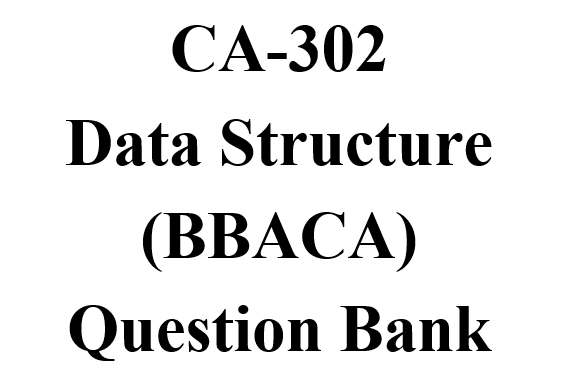CA-302 Data Structure (BBACA) || Question Bank
Two marks.
1. What is linear data structure? Give an example.
2. Define the space and time complexities of an algorithm.
3. What is recursion?
4. What is dynamic memory allocation?
5. Define stack.
6. Compare linear search and binary search methods.
7. What is a circular queue?
8. Write the differences between stack and queue.
9. Give the node structure of a doubly linked list.
10. Define the terms :
i) Binary tree.
ii) Complete binary tree.
11. Mention the different ways of tree traversal.
12. Mention the graph traversal methods.
13. Define the data structure.
14. What are linear data structures? Name any two linear data structures.
15. Define the terms :
i) Space complexity.
ii) Time complexity.
16. Mention the disadvantages of an array.
17. Define sparse matrix.
18. What is a linked list?
19. Mention various types of linked lists.
20. Differentiate between stacks and queues.
21. Mention the applications of stack.
22. What is a circular queue?
23. Define the terms :
i) Graph
ii) Tree.
24. Give examples for :
i) Complete binary tree.
ii) Degree of the vertex.
25. What is a non-linear data structure?
26. Define the space and time complexity of an algorithm.
27. What is recursion?
28. What is dynamic memory allocation?
29. What is a circular queue?
30. Compare linear search and binary search techniques.
31. Write 'C' function to find the number of characters in a string.
32. Differentiate between the terminal and non-terminal nodes of a tree.
33. List the disadvantages of a Linked List.
33. Mention different ways of graph traversals.
34. List different operations on Binary Tree.
35. What is a Binary Search Tree?
Four marks.
1) Explain various types of data structures.
2) Briefly explain any four string handling functions.
3) Explain the selection sort algorithm.
4) Write an algorithm to delete an element from the array.
5) Define the linked list. Mention the applications of the linked list.
6) Write an algorithm for searching a node in the singly linked list.
7) Mention various applications of the stack.
8) Evaluate the following postfix expression
95 + 36++97 1.
9) Write C functions to perform insertion and deletion operations of a queue.
10) What is a queue? Mention its underflow and overflow conditions.
11) Briefly explain infix, prefix, and postfix expressions.
12) Convert the following infix expression into its equivalent postfix expression
(a + b) « (m/n) + (x + y).
13) Define the terms (a) Graph (b) Degree of a vertex.
14) Write a depth-first-search algorithm.
15) Define the Binary search tree. Give an example.
16) Briefly explain various tree traversal methods with suitable examples.
17) Explain various operations performed on data structures.
18) Illustrate asymptotic notations with examples.
19) Write an algorithm for inserting an element into a linear array.
20) Write a C program to sort N elements using bubble sort.
21) Explain the node structure of a singly linked list. Mention the advantages of linked lists over arrays.
22) Write an algorithm to insert a node at the end of the linked lsit.
23) Write a menu-driven C program to implement stack operations.
24) Explain the selection sort algorithm with an example.
25) Evaluate the following postfix expression 65 * 78 + * 87 - 45 * ++
26) Explain BST.
27) Write recursive functions for tree traversals.
28) Explain adjacency matrix and adjacency list with suitable examples.
29) Write Depth First search algorithm to traverse a graph.
30) Explain any four mathematical functions.
31) Write C functions to implement the following string handling functions.
i) String length
ii) String concatenation.
without using built-in functions.
32) Write an algorithm to insert an element into an array at a specified
33) Write a C program to extract a substring from a given string.
34) Write a C function to perform insertion and deletion operations on the stack.
35) Write a C function to implement bubble sort.
36) Define a Linked List? Explain different types of linked list, and mention the advantages of linked lists.
35) Write an algorithm to insert a node at the beginning of a linked list.
36) Write an algorithm to delete an element into the priority queue.
37) Write an algorithm to evaluate postfix expression.
38) What is a double-ended queue? Write an algorithm to insert an element at the rear end of the deque.
39) What is Queue? Mention applications of the queue.
40) Explain strictly and complete binary tree with examples.
41) Write an algorithm for the following :
(i) In order tree traversal
(i) Post order tree traversal
(ii) Preorder tree traversal.
43) Write an algorithm for Breadth-first search.
44) Define the properties of the Binary Tree.






0 Comments